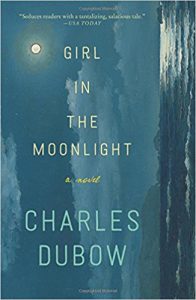Girl in the Moonlight, by Charles Dubow
Girl in the Moonlight
By Charles Dubow
William Morrow
Two stars
Reviewed by Jessica Gribble
Some novels start with a clichéd concept and turn it into something out of the ordinary. Unfortunately, in Girl in the Moonlight, Charles Dubow starts with a clichéd concept (a boy falls in love with a bewitching girl) and lets that cliché play out without twists or surprises. She’s no good for him, but he can’t stop thinking about her. She treats him badly. He continues to want her.
The boy, Wylie Rose, becomes a man through the course of the novel. His father is friends with one of the members of the wealthy, artistic Bonet family. If Wylie’s family had been poor, the book could’ve included some interesting social commentary. Instead, Wylie can basically pursue whatever life course he wants. Of course, what he truly desires is the eldest Bonet sister, Cesca. “I stared at her. Even at that age everything about her seemed authentic. She was almost a teenager. On her slender frame her breasts were just beginning to bud. It was clear she would be a great beauty. Already her parents’ friends noticed it. That was not how I saw her. To me, at that moment, she was already perfect, blinding.”
I’m sorry to tell you she gets no more enchanting than that. A book about an obsession, which is how this book is billed, can be terribly powerful, but I ended up feeling sorry for Cesca. We’re told time and again that she’s the sort of woman no one can look away from, but we’re never shown why. She and Wylie have no chemistry despite his professed obsession. They rarely speak to each other. In fact, Dubow is so busy name-dropping, all the characters are underdeveloped. For example: “In her apartment were unopened boxes from Chanel, Hermès…. We did eventually go to Charvet, where, to my embarrassment, she insisted on buying me a dozen shirts of every hue.”
So what happens? Wylie becomes good friends with Cesca’s artist brother, Aurelio. He stays in occasional contact with the Bonet family. He considers being an artist himself, and takes an apprenticeship, but eventually realizes he’s not talented enough and becomes an architect. When Cesca wants him, he comes, and they always end up in bed together. Alas, the sex is as tepid as the dialogue. One of the hallmarks of obsession is that it can wreck your life, but Wylie’s oft-professed love for Cesca only inconveniences him. Dubow might actually have been obsessed with a person or two in his life: near the end of the novel, a few thoughts about obsession ring true. Too bad the lack of frisson between the characters wins out.
Sometimes brilliant writing can overcome a boring plot, but instead we read: “They ate like hunters, their insides hollow from the exertion of love and sport.” And “To the left, a simple wooden table surrounded by chairs, its surface smooth with the memory of many meals.”
This book might appeal to a young person who’s charmed by the idea of living such a lavish life, filled with artists, writers, musicians, travel to foreign cities, and always plenty of money. Dubow obviously enjoys the fine arts—or studied up on them. But in the early 1980s, Judith Krantz wrote a romance novel called Mistral’s Daughter that’s also set in the art world ; it has a dynamic plot, a terribly captivating main character, hints of obsessive love, and sexual tension that crackles. Comparatively, Girl in the Moonlight is milquetoast. In the end, this is a mediocre book written by a mediocre writer who has nothing new to say about love, obsession, responsibility, or art.
